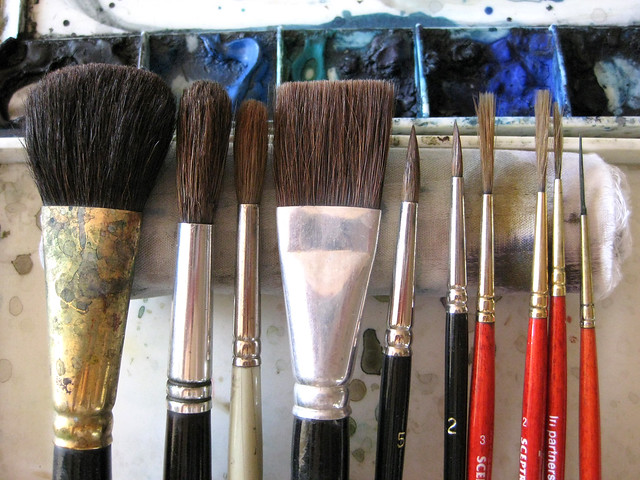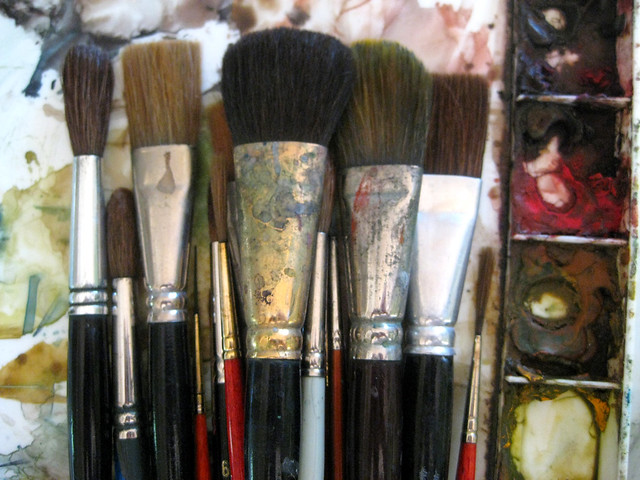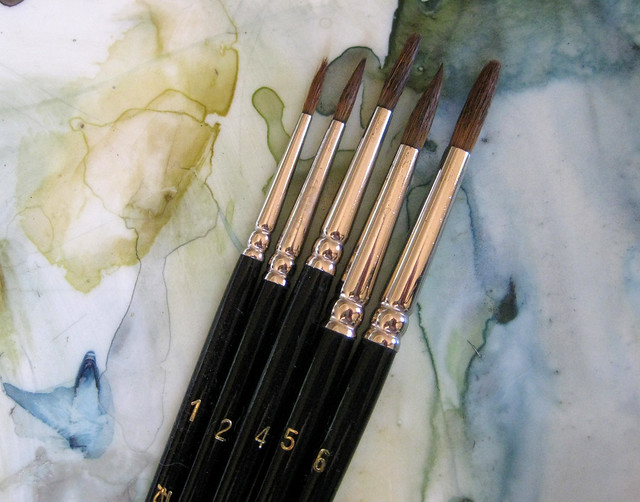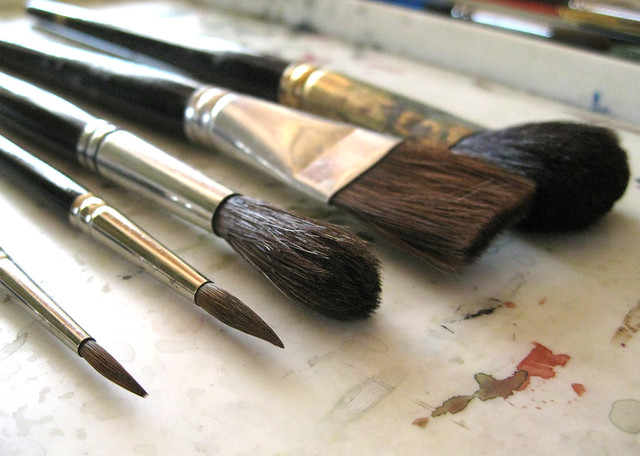Using the best quality brushes will yield better results.
So, how do you choose? Your selection will be made by these four factors:
First, you need watercolor brushes.
Oil, acrylic and craft brushes are made for a
different purpose and are not suitable for watercolor.
I prefer to use kolinsky red sable brushes made from
the soft tail hairs of the siberian weasel.
They are expensive brushes but well worth it because
the natural coat and taper of the hairs holds the paint
really well and they maintain their shape
and point much longer with proper care.
different purpose and are not suitable for watercolor.
I prefer to use kolinsky red sable brushes made from
the soft tail hairs of the siberian weasel.
They are expensive brushes but well worth it because
the natural coat and taper of the hairs holds the paint
really well and they maintain their shape
and point much longer with proper care.
If you prefer not to use animal hair
or would like more economical brushes,there are
wonderful synthetic watercolor brushes
that you can use as well.
or would like more economical brushes,there are
wonderful synthetic watercolor brushes
that you can use as well.
Brushes come in all different shapes and sizes.
You will want to be able to make a variety of marks
from very large washes to fine little details.
Brushes are numbered to correspond with size
from small to large. Every brand is slightly different.
from very large washes to fine little details.
Brushes are numbered to correspond with size
from small to large. Every brand is slightly different.
Honestly, you really only need five brushes to get started.
It's nice to have more, but they are not necessary
and you can always add to your collection.
I would recommend starting with one large round or
oval brush for big washes, one large or medium flat brush
for washes and painting a straight edge,
one medium pointed round and one small pointed round
for finer brush strokes,and a rigger or liner brush,
which makes a beautiful fine line.
The rigger is my favorite brush.
I have them in several sizes.
and you can always add to your collection.
I would recommend starting with one large round or
oval brush for big washes, one large or medium flat brush
for washes and painting a straight edge,
one medium pointed round and one small pointed round
for finer brush strokes,and a rigger or liner brush,
which makes a beautiful fine line.
The rigger is my favorite brush.
I have them in several sizes.
Every brush has this basic anatomy:
a handle, a ferrule, and a brush head.
a handle, a ferrule, and a brush head.
When looking for a brush, these three parts should fit
tightly and seamlessly together. A new sable brush head
will be stiffened with gum arabic to hold its shape
tightly and seamlessly together. A new sable brush head
will be stiffened with gum arabic to hold its shape
and it will need to be rinsed in cool water before using it
for the first time.The hairs should not appear
misshapen, frayed, split or crooked.
for the first time.The hairs should not appear
misshapen, frayed, split or crooked.
With proper care your brushes will last a long time.
I have ruined quite a few brushes over the years
and my dog has chewed a few handles much to my dismay
(see the picture above).
Here are a few tips for keeping your brushes in good condition:
I have ruined quite a few brushes over the years
and my dog has chewed a few handles much to my dismay
(see the picture above).
Here are a few tips for keeping your brushes in good condition:
Don't use your brushes for anything but watercolor paint.
When you are working, gently mix your paint by swirling
and rolling the brush through it, don't smash the tip
into the paint or it will quickly fray and lose its shape.
and rolling the brush through it, don't smash the tip
into the paint or it will quickly fray and lose its shape.
Don't leave your brushes soaking in water as this will
loosen the handle and ferrule, not to mention
that the brush head will become misshapen.
loosen the handle and ferrule, not to mention
that the brush head will become misshapen.
I rest my brushes on a little rolled up rag next
to my palette while I am working.
to my palette while I am working.

Rinse your brushes in cool water when you are finished
painting for the day. Remove paint residue from the brush
and ferrule and tease out any loose hairs. Pat dry and
reshape the tips of your brushes with your fingers.
Store your brushes in a container or rest them on a
ledge or in a brush holder so that the brush heads
are not resting against or touching any surface.
ledge or in a brush holder so that the brush heads
are not resting against or touching any surface.
You can also use a brush soap or a very mild soap
to thoroughly clean your brushes, but you don't want
to strip the oils from the natural brushes
by doing this too often.Synthetic brushes are less
fragile and a little easier to clean.
to thoroughly clean your brushes, but you don't want
to strip the oils from the natural brushes
by doing this too often.Synthetic brushes are less
fragile and a little easier to clean.
Places to shop for watercolor brushes:
Do you have any questions about watercolor brushes?
Experiment and see what works for you!
Next time 101 is all about paper.






Thanks for posting your tutorials! Really fun and helpful.
ReplyDeleteMy pleasure Anne-Marie!
ReplyDeleteThank you Holly for the wealth of information. I wish we could all peek over your shoulder and watch you do your magic with watercolors.
ReplyDeleteI also love riggers they are so useful. I still have my first rigger rather worn and scary looking when dry but still comes to a fabulous point when wet.
I'm really enjoying this! Thank you!
ReplyDeleteThank you so much for posting the watercolour 101's they are so interesting and really helpful! Love it :)
ReplyDeleteThen it must be my brushes' fault that I can't paint! ;) :D
ReplyDeleteVery helpful indeed. Now my brushes will survive much longer :)
ReplyDeleteArtist: I'm not sure if it's magic, but thank you! I can't live without my riggers. I have a few old ones that I have cut down to a few hairs so that it makes a really thin line.
ReplyDeleteCarol and Lamina: glad you are enjoying this. I am too. It makes me think about how I work, which I don't do very often.
Maria-Thérèse: You are too funny! I'm sure your painting is just lovely.
Anne: I hope this will help preserve your brushes! I've ruined so many over the years and I could kick myself for it!
Lovely advice! My favourite brush is my Windsor & Newton Pure Squirrel Petit Gris Pur (2). It holds a good amount of pigment but still has a nice tapered point.
ReplyDeleteClair: Isn't it so funny how we all have our pet brushes?
ReplyDeleteHolly you are so right about how hard other types of pigment are so hard on good brushes. I learned with a treasured k. sable round I used it first for watercolor for pottery underglazes ; I used it for years, but all the hairs broke off one by one, and now its more like a liner!
ReplyDeleteReally apprecaite all you input on supplies
xx
julie
Thank you again for this series.
ReplyDeleteIt's all been very helpful.
Julie: All I can say is never use your watercolor brushes to glue anything! Tears will follow.
ReplyDeleteMary: My pleasure. Thanks for stopping by.
This is a lovely blog post and your photography just gorgeous! I am guilty of inflicting mindless abuse on brushes - but only the cheaper ones. The better ones have special labels on them just as a double-reminder to myself. Thanks & best wishes! Cathy
ReplyDeleteYay! I'm so excited for this watercolor 101 series. I'm really enjoying it. I don't paint often or well, but when I do, it is so relaxing to me and I appreciate learning the basics. Thank you for taking the time to write them out.
ReplyDeleteCathy: What a treat! Thanks for stopping by! Your work is truly stunning! Trust me, I've done the same.
ReplyDeleteElisa: I'm glad the series is helpful. Next time I'll focus on watercolor paper. stay tuned.
Dear Golly Bard,
ReplyDeleteI am sorry for not having commented on your wonderful posts. I have been away on a easter break but stoped in internet points to read them! :) Yesterday I set out and bought 2 riggers!!!!! A numer 2 and a 02. They are ox hair, and together they cost 8 euros. Ox hair isn't the softest but I think they work well... the thing is... I understad they are for line making, but, in what way are they better than a normal size brush? It seems I cant handle doing fast lines with it so maybe its for longer straighter lines? When you paint do you press all the hair on the paper or only use the point? Sorry for all the questions and thank you thank you thank you!
p.c
beautiful pictures, touching an artists heart...
ReplyDeletebest wishes, Stefanie
PC: It's great that you are getting started. The rigger makes a beautiful calligraphic line, but it is only useful for fine or detailed work. It's not better than other brushes, each is type is needed for making a variety of marks. I just happen to love this brush because it lends itself to my style of painting. Experiment with how you hold your brushes and how much pressure you put on any of your brushes. More or less pressure will vary the brush stroke from thick to thin and will vary the marks you make.
ReplyDeleteStefanie: Thank you kindly!
Thank you! I love your calligraphy and your style. I will try to work with it to see If I can manage it better. I guess the long hairs help hold more ink. I have recently discovered a Spanish brand of brushes called ESCODA and I am very pleased with them also.
ReplyDeleteThank you very much... and looking forward to your paper post!
p.
i love your artwork.
ReplyDeleteHi!
ReplyDeleteReally good tips on brushes! I´m curious what brushes that´s in your pictures?
Really good tips on brushes!! I´m curious what brushes did is on the pictures?
ReplyDelete